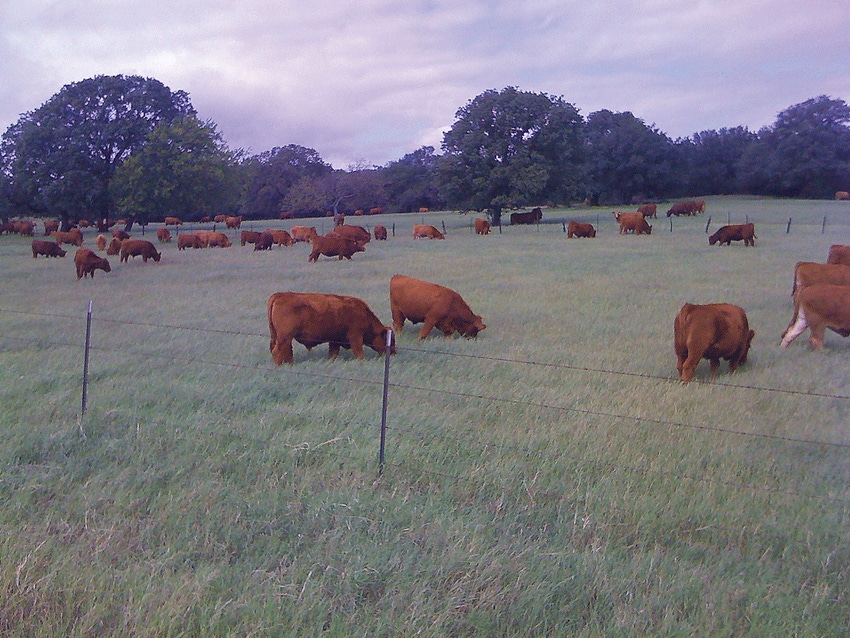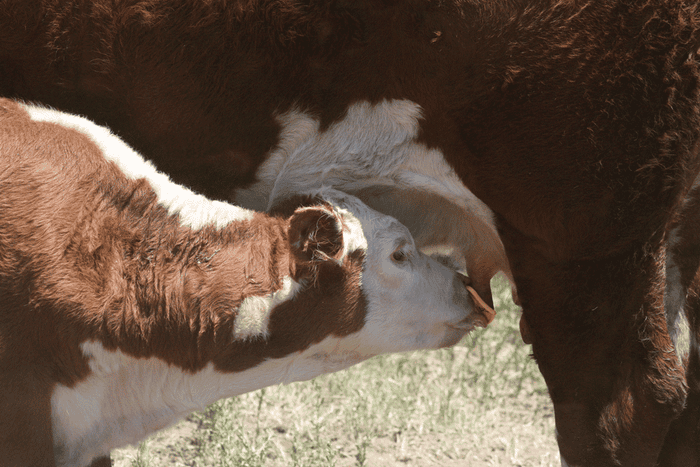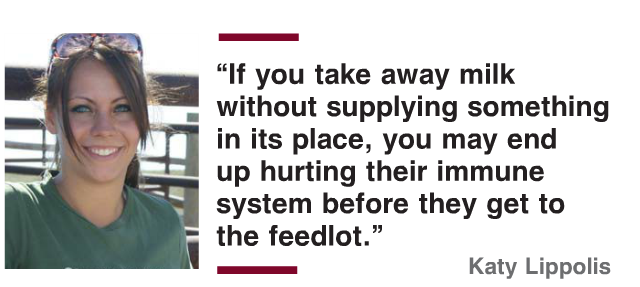Weaning time is one of the most stressful events in a calf’s life. Here�’s how to make it easier on both you and your cattle.
July 31, 2017

When it comes to weaning calves, an old saw comes to mind — ask 10 ranchers how to best wean calves and you’ll get 11 different answers. There are many ways to wean calves, but the goal is to minimize stress: to keep calves healthy, growing and gaining — without setbacks.
Indeed, weaning is the most stressful time in the life of a calf, says David Bohnert, beef Extension specialist and ruminant nutritionist at Oregon State University. And weaning time is just the start; many calves go through additional stresses, such as vaccination; transportation; commingling with other calves at a sale barn, growing lot, stocker pasture or feedlot; and having to adjust to a new environment.
Compounded stresses resulting in illness or slower weight gain translates into less money for whoever is unlucky enough to own a set of calves that weren’t properly prepared for weaning and beyond. “Work done by our lab demonstrated that for each one-tenth pound of gain during the receiving period [above that of the stressed calves], we see almost a 20-pound increase in hot carcass weight at the end of the finishing period,” Bohnert says.
At current prices, that equates to a $35 to $40 increase in value at harvest. “Lower stress at weaning time not only increases carcass value, but saves money in costs of treatment for sick calves,” he says.
“If you retain ownership when you move calves to a growing lot or feedlot, it is advantageous to keep them home and put some age on them after weaning, and not send them until they’ve overcome the stress. This will decrease the number that get sick and increase gain. You can dramatically decrease costs associated with health care in the feedlot if you allow those calves 30 to 45 days at home after weaning [Vac45 program],” Bohnert says.
Weaning strategies vary, depending on facilities and age of calves being weaned, says Ron Gill, associate department head, Extension, at Texas A&M University. “The traditional weaning age is from about 5 to 8 months of age, sometimes older. Low-stress methods include fenceline weaning and two-stage weaning with nose flaps,” he says.
Nose-flap weaning

Nose flaps are considered by many to be the least-stressful method of weaning. While using the nose flaps is a little more management-intensive, calves stay with their mothers during the weaning process. Since the calves can’t nurse, but can eat and drink from a bunk and a water source, weaning occurs without the usual bawling and pacing.
The flap doesn’t hinder eating or drinking, but makes it difficult to suckle. After nose flaps are installed, calves go back with the cows and go through the first phase of weaning. They’re unable to suckle, so the cow’s milk dries up — while the calf is still with its dam.This greatly reduces stress; the calf still has its mama for companionship and security, and the cow isn’t worried about her calf because it’s still with her. After five to seven days, the flaps are removed and the pairs can be separated, and they aren’t upset because weaning has already been accomplished.
Katy Lippolis, a graduate fellow in animal and rangeland sciences at Oregon State University, did her master's degree work at Colorado State University looking at low-stress weaning using nose flaps. Her current doctoral work at OSU is focused on management of weaned calves to mitigate the negative effects of stress, and optimize health and productivity in the feedlot.
“Much of my master's work was to evaluate weaning with nose flaps and how this affected cow performance, calf performance and carcass quality,” she says. Most producers who try nose flaps say it’s the least stressful way they’ve weaned calves.

“Anything you can do to reduce stress is beneficial,” says Gill. “The important thing is to not do anything else to cattle on the day you wean. This is difficult for some operations if they don’t have many opportunities to get cattle in, so they want to process the calves or the cows when they separate and sort off the calves — even though you want that day to be as quiet as possible for those cattle,” he explains.
Fenceline weaning
“A study at Ohio State University showed that with fenceline weaning, only about 15% had to be treated for BRD [bovine respiratory disease]. That number was doubled for calves that had to be transported at weaning. Almost 45% of calves put into a feedlot or drylot needed treatment,” Bohnert says.
Situations where Gill has seen fenceline weaning not work are when people process cattle, get them stirred up and stressed, and then put calves on one side of a fence and the cows on the other. “The cows and calves are in panic mode already, and may go through or over a fence to try to get back together,” Gill says.
With fenceline weaning, plan ahead to have adequate grazing for the calves. “Otherwise, you need to provide good hay, silage or a grain mix during this transition. That can run up your cost so much that it becomes unprofitable. Calculate the value of gain to see if it pencils out,” Gill says.
This kind of decision is never static; these factors are never exactly the same from year to year. “From a stewardship standpoint, I feel every rancher should wean calves at home. Yet from an economic standpoint, this may not always be best. If we can get them weaned at home, however [even at breakeven, financially], it’s better for the cattle and for the industry,” Gill stresses. The calves are less at risk for illness and will do better for the next owner.
“There are times, however, that it may be best to just send calves to town, right off the cow, if somebody else can manage them better. Some people have tried to keep calves at home and didn’t have the facilities, time or labor to do it right, and it turned into a bad deal. Those calves would have been better off shipped to someone else who had the time and resources to manage them correctly,” says Gill.
Nutrition
Regardless of the weaning strategy used, you must meet calves’ nutrition requirements. “We are removing an extremely nutritious food source, so we must give them an alternative,” says Lippolis. “If you take away milk without supplying something in its place, you may end up hurting their immune system before they get to the feedlot.”
This could be as easy as saving your best pasture for weaning calves, she says. Depending on feed prices, you could also take advantage of a creep-feeding program ahead of weaning, to get the calves accustomed to eating highly nutritious feed.
Many people think weaned calves need to gain 2 to 2.5 pounds a day, but this can be expensive if you are buying feed. “When you factor in the value of that gain, you may be losing money,” Gill says.
If you have to wean calves in a corral rather than on pasture, get them used to eating the new feed before you wean them so it’s not an abrupt change. “You need to do this while they are still on the cow,” he says.
Calves will try the feed more readily when they are not stressed, and they sample new feed if they see Mama eating it. “This is learned behavior. Here in Texas, a lot of producers use cottonseed meal pellets or cubes as a supplement during weaning. We might feed some in the summer on pasture, just to get calves used to eating it with their mothers. Then they will eat it from Day 1 when you wean,” Gill says.
“If they aren’t eating, it stresses their immune system. Usually if calves will eat, and maintain or gain weight through the first seven to 10 days, they won’t get sick. It’s when they won’t eat and won’t drink that they get into trouble,” he adds.
The important thing when weaning is the transitional period before you stress the calves again. “There has been a lot of research regarding the best length of time before you ship them. That’s where the Vac45 program came into being, looking at a 45-day window. Some producers try to cut that down to 21 or 30 days, based on how much feed they have for those calves, but that may not work as well,” says Gill.
Vaccinations
Gill says it’s best to give calves vaccinations before weaning, so they have some immunity to the most common viral diseases before they are stressed. “In our research, the best thing we found was what we developed many years ago in our Ranch to Rail program, where the Vac45 protocols evolved. It worked best when ranchers were able to gather cattle a month before weaning and give calves the viral and clostridial shots, and then boost those a week after weaning. It’s not a good idea to do anything with the calves right at weaning, because you want that to be a stress-free day,” he says.
Another method that works well is to vaccinate calves at branding, with a viral component as well as clostridial vaccination. You don’t get much immune response at that time, but it creates a memory response.
“Then when the immune system sees that antigen again at weaning time, that second shot produces enhanced immune response. You can get the calves weaned and give them that booster within 10 days,” says Gill.
“The third-best thing, if you didn’t get any vaccinations into calves at branding, is to vaccinate at weaning and then booster 14 to 21 days later — though I think it’s best to wait at least seven to 10 days before you put the first round into them, so you aren’t stressing them so much on weaning day,” Gill says.
Ask your veterinarian whether you need Pasteurella or Histophilus somni, and which clostridial vaccines to use. “Those gram-negative vaccines are pretty stressful, so you don’t want to stack too many at the same time. Often, we add pasteurella to a vaccine protocol way too late. It should probably be given 90 days before the cattle are stressed or exposed, but most protocols today require it to be a component of the Vac45 verification program,” Gill says.
Smith Thomas is a rancher who writes from Salmon, Idaho.
About the Author(s)
You May Also Like



